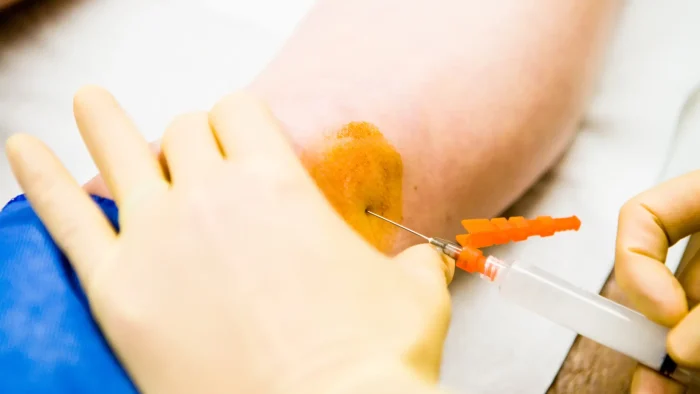
Knee osteoarthritis (OA) affects over 365 million people worldwide, with treatments like hyaluronic acid (HA) injections proving effective in managing pain and improving joint function.
One such treatment is Hymovis, a high-molecular-weight viscoelastic hyaluronan that relieves knee osteoarthritis pain. This injectable therapy acts as a lubricant and shock absorber within the knee joint, providing relief for patients who have not responded to other treatments.
In this article, we will explore the Hymovis FDA approval, its effectiveness, potential side effects, and how it compares to other osteoarthritis treatments available on the market.
Key Takeaways
- Hymovis is an FDA-approved, high-molecular-weight hyaluronic acid injection designed to treat knee osteoarthritis by improving joint lubrication and reducing pain.
- It was approved in 2015 after clinical trials demonstrated its safety and effectiveness. It provides an important non-surgical treatment option for osteoarthritis patients.
- Hymovis typically requires just two injections, offering long-lasting relief for up to six months.
- Clinical trials and real-world studies have shown that Hymovis significantly reduces pain and improves joint function in patients.
About: Doctor Medica is your trusted supplier of top-quality dermal fillers, viscosupplements, and more for your medical practice. We offer genuine products from leading brands at the lowest prices in the market. If you’re looking to order Hymovis online for your practice, contact the Doctor Medica today.
The FDA Approval Process for Hymovis
The FDA approval process for medical products like Hymovis is rigorous and involves several key stages to ensure patient safety and product effectiveness. Before any medical device or treatment is approved for public use, it must undergo thorough preclinical testing, clinical trials, and regulatory review. This process is designed to confirm that the product meets the necessary safety standards and provides a meaningful benefit to patients.
Specific regulatory requirements apply for medical devices such as Hymovis, which is a hyaluronic acid-based viscosupplement for knee osteoarthritis. These include demonstrating biocompatibility (proving that the product works well with the body’s natural tissues) and safety (showing that it does not cause harmful side effects).
Additionally, effectiveness must be proven through clinical trials, which test how well the device alleviates symptoms like knee pain and stiffness.
In terms of timeline, Hymovis received FDA approval in 2015 after completing clinical trials that demonstrated its safety and efficacy. This approval marked a significant milestone, offering patients with osteoarthritis a non-surgical option for managing chronic knee pain when other treatments fail.
Safety Evaluations and Clinical Trials

Hymovis has undergone extensive safety evaluations to ensure its efficacy and safety for patients with osteoarthritis. Clinical studies have shown that Hymovis has an excellent safety profile, with no reports of serious adverse events, including pseudoseptic reactions.
The most commonly reported adverse event is arthralgia (joint pain), which occurs at a rate similar to that of saline injections. Additionally, no patients discontinued the use of Hymovis due to adverse events after six months, and it has been established as safe for repeat use.
Clinical trials have demonstrated the efficacy of Hymovis in reducing pain and improving joint function in patients with knee osteoarthritis. A pivotal trial showed a 34% reduction in WOMAC/VAS pain score at six months, while a post-market clinical trial reported a 37% reduction in VAS pain scores.
Real-world clinical practice studies have also shown reductions in pain scores by up to 57%. These results highlight Hymovis’s ability to provide significant pain relief and improve the quality of life for patients with osteoarthritis.
Unlike corticosteroids, which can have systemic side effects, Hymovis offers a localized treatment with fewer adverse effects. Additionally, Hymovis is more effective than saline injections in reducing pain and improving joint function.
Reassuring Patients and Healthcare Providers

Patients and healthcare providers may have concerns about the safety and efficacy of Hymovis, but extensive clinical trials and FDA approval confirm it as a reliable treatment for knee osteoarthritis. Side effects like temporary swelling are minimal, and Hymovis helps reduce pain and improve mobility through enhanced joint lubrication.
For osteoarthritis patients, Hymovis offers long-lasting relief with just two injections. It provides a non-surgical alternative to managing pain and potentially delaying knee replacement. Its high-molecular-weight hyaluronic acid formulation mimics natural joint fluid, improving joint function and quality of life.
When comparing Hymovis vs Synvisc, both are effective, but Hymovis requires fewer injections, which may be more convenient. Healthcare providers should assess patient needs and past treatment responses to determine the best option.
Conclusion
Hymovis received FDA approval in 2015, marking it as a safe and effective treatment option for knee osteoarthritis, especially for patients who have not found relief with other therapies. This approval underscores Hymovis’ proven ability to reduce pain and improve joint function, providing renewed hope for those managing chronic knee pain.
For individuals suffering from knee osteoarthritis, Hymovis offers a promising solution to restore mobility and enhance overall quality of life.
FAQs
1. How does Hymovis work for knee osteoarthritis?
Hymovis is a hyaluronic acid-based injection that acts as a lubricant and shock absorber within the knee joint. By mimicking natural joint fluid, it reduces friction between the bones, alleviating pain and improving mobility.
2. How many injections are required with Hymovis?
Hymovis requires only two injections, spaced one week apart, to effectively relieve knee osteoarthritis, offering long-term results for up to six months.
3. Who is eligible for Hymovis treatment?
Hymovis is approved for adults with knee osteoarthritis, particularly those who have not found relief from other treatments like physical therapy or pain medications.
References
Crockett, Z., Asikhia, O., Rhim, H. C., & Malik, G. R. (2024). Injection-based Therapies for Knee Osteoarthritis: A Comprehensive Update. Current Physical Medicine and Rehabilitation Reports, 12(3), 256-265.
McElheny, K., Toresdahl, B., Ling, D., Mages, K., & Asif, I. (2019). Comparative Effectiveness of Alternative Dosing Regimens of Hyaluronic Acid Injections for Knee Osteoarthritis: A Systematic Review. Sports Health, 11(5), 461–466. https://doi.org/10.1177/1941738119861545
Related Articles
Joanna Carr
When Does Nexplanon Start Working? – Timing and Effectiveness
Discover the timing and effectiveness of Nexplanon. Understand how quickly this birth control implant begins to work, factors that influence its effec...
Joanna Carr
BioRePeel vs PRX-T33 – Do They Complement Each Other?
Discover how BioRePeel and PRX-T33 differ in formulation, depth, and skin concerns -- and whether combining them can enhance rejuvenation results.
Joanna Carr
Beyond the Lab: Orthovisc and Biotechnology Advancements
Explore Orthovisc and biotechnology innovations. Discover advanced solutions for joint health. Know more from Doctor Medica for expert insights.


